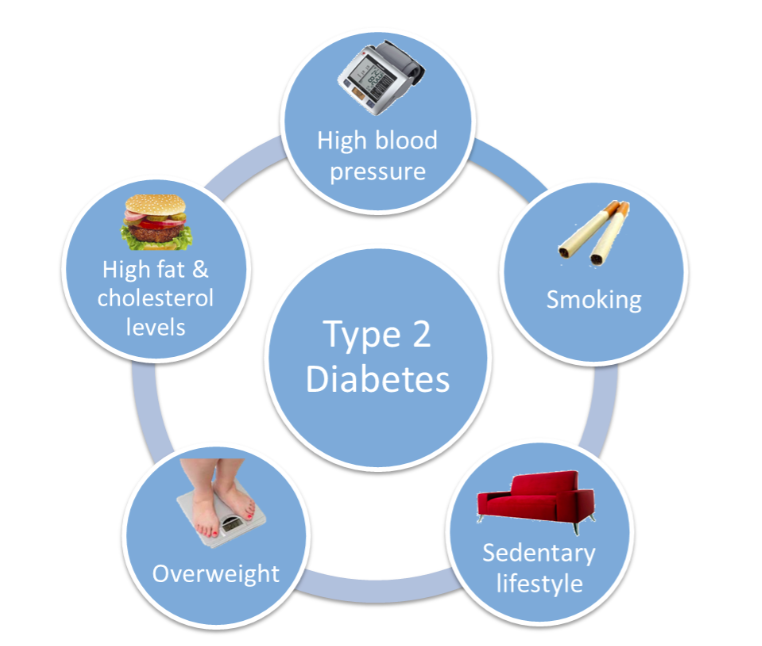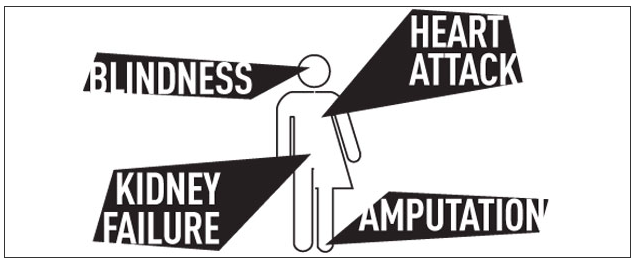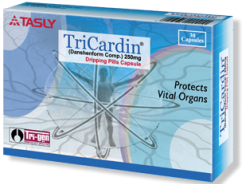Diabetes and its Complications
(PRODUCTS IN FOCUS: TRICARDIN & MONACOLIN-K )
Definition of Diabetes
Diabetes is a condition where the amount of glucose in your blood is too high because the body cannot use it properly. This is because your pancreas doesn’t produce any insulin, or not enough insulin, to help glucose enter your body's cells – or the insulin that is produced does not work properly (known as insulin resistance).
- Insulin is the hormone produced by the pancreas that allows glucose to enter the body's cells, where it is used as fuel for energy so we can work, play and generally live our lives. It is vital for life.
- Glucose comes from digesting carbohydrate and is also produced by the liver.
- If you have diabetes, your body cannot make proper use of this glucose so it builds up in the blood and can't be used as fuel.
- There are two main types of diabetes: Type 1 diabetes and Type 2 diabetes.
Diabetes develops when glucose can't enter the body's cells to be used as fuel.
This happens when either:
- There is no insulin to unlock the cells (Type 1). Type 1 diabetes accounts for about 10 per cent of all adults with diabetes and is treated by daily insulin injections, a healthy diet and regular physical activity. Type 1 diabetes can develop at any age but usually appears before the age of 40, and especially in childhood. It is the most common type of diabetes found in childhood.
- There is not enough insulin or the insulin is there but not working properly (Type 2). Type 2 diabetes usually appears in people over the age of 40, though in South Asian people, who are at greater risk, it often appears from the age of 25. It is also increasingly becoming more common in children, adolescents and young people of all ethnicities. Type 2 diabetes accounts for between 85 and 95 per cent of all people with diabetes and is treated with a healthy diet and increased physical activity. In addition to this, medication and/or insulin are often required.
Diabetes risk factors:
- You are over 40 (or over 25 if you are South Asian)
- You have a close family member with diabetes (parent, brother or sister)
- You are overweight, with a large waist size (over 80cm (31.5 inches) for women, 94cm (37 inches) for men, or 89cm (35 inches) for South Asian men)
- Being South Asian, Black African, African Caribbean
- You have ever had high blood pressure, a heart attack or a stroke
- You're a woman with polycystic ovary syndrome and overweight
- If you're a woman and you've had gestational diabetes or given birth to a baby over 10 pounds
- If you have a severe mental illness for which you take medication (such as schizophrenia, bipolar illness or depression)
- You've been told you have impaired glucose tolerance or impaired fasting glycaemia.

Diabetes and its complications:
Impaired microcirculation is the key to developing long-term complications. When microcirculation in the body is compromised and blood flow to the extremities and nerves is affected; acute diabetic complications arise which endanger your life and your wellbeing. Having diabetes exposes one to a multitude of complications. Long-term complications include how diabetes affects your eyes (retinopathy), heart (cardiovascular disease), kidneys (nephropathy), nerves and feet (neuropathy) and diabetic foot ulcer.

How can diabetes affect your feet?
If it is poorly controlled, diabetes can damage nerves and blood vessels. Nerve damage is called neuropathy. Diabetes may also affect the circulation by causing the arteries to become 'furred up' (artherosclerosis). This can affect all the major blood vessels, especially those supplying the feet. Without a good blood supply, you will have problems with cuts and sores, which do not heal very well, and as a result of poor circulation, you may also suffer from cramp and pain in your legs and/or feet. If your diabetes is poorly controlled, you run greater risk of poor circulation and the problems associated with a poor blood supply to your feet. High blood pressure; a high fat content in your diet and, in particular, smoking, all increase the risk of poor circulation.
Cardiovascular Problems:
Capillaries are the tiny vessels where the exchange of oxygen and carbon dioxide takes place. When damage occurs to these vessels it’s referred to as microvascular disease.
When fatty materials such as cholesterol form deposits on the walls of the vessels (known as plaque), furring up the artery and reducing the space for blood to flow, this is described as arteriosclerosis or atherosclerosis. If the plaque ruptures the artery walls, blood cells (called platelets) try to repair the damage, but this will cause a clot to form. Over time, the walls of the blood vessels lose their elasticity. This can contribute to the development of high blood pressure or hypertension, which can cause more damage to the blood vessels.
The force of the blood being pumped from the heart can make the clot break away from the artery wall and travel through the system until it reaches a section too narrow to pass through. If this happens the narrow section will become partially or completely blocked.
Blockage of an artery leads to the part of the body it supplies being starved of the oxygen and nutrients it needs. This is the cause of heart attack or strokes (affecting the brain).
Narrowing of the blood vessels can affect other parts of the body, such as the arms or legs. This is called peripheral vascular disease (PVD). PVD may produce intermittent claudication (pain in the calf muscle). If left untreated, amputation of the limb may eventually be necessary.
What causes retinopathy?
Diabetic retinopathy or 'retinopathy' is damage to the retina (the 'seeing' part at the back of the eye) and is a complication that can affect people with diabetes.
The retina is the light-sensitive layer of cells at the back of the eye – the 'seeing' part of the eye. A delicate network of blood vessels supplies the retina with blood. When those blood vessels become blocked, leaky or grow haphazardly, the retina becomes damaged and is unable to work properly. Retinopathy is damage to the retina. Persistent high levels of glucose can lead to damage in your eyes.
What is neuropathy?
Neuropathy is one of the long-term complications, which affects the nerves. Nerves carry messages between the brain and every part of our bodies, making it possible to see, hear, feel and move. Nerves also carry signals that we are not aware of to parts of the body such as the heart, causing it to beat, and the lungs, so we can breathe. So, damage to the nerves can cause problems in various parts of the body.
Diabetes can cause neuropathy as a result of high blood glucose levels damaging the small blood vessels which supply the nerves. This prevents essential nutrients reaching the nerves. The nerve fibres are then damaged or disappear.
What is kidney disease (nephropathy)?
Kidney disease can happen to anyone but it is much more common in people with diabetes and people with high blood pressure. Kidney disease in diabetes develops very slowly, over many years. It is most common in people who have had the condition for over 20 years. About one in three people with diabetes might go on to develop kidney disease.
As kidney disease progresses, the kidneys become less and less efficient and the person can become very ill. This happens as a result of the build up of waste products in the blood, which the body cannot get rid of. Kidney disease can be a very serious condition.
Why are people with diabetes more at risk?
Kidney disease is caused by damage to small blood vessels. This damage can cause the vessels to become leaky or, in some cases, to stop working, making the kidneys work less efficiently. Keeping blood glucose levels as near normal as possible can greatly reduce the risk of kidney disease developing as well as other diabetes complications. It is also very important to keep blood pressure controlled.
Connection between diabetes and stroke:
If you have diabetes and hypertension (high blood pressure) you are about twice as likely to have a stroke as somebody with hypertension alone. Your risk of transient ischemic attacks is between two and six times higher than somebody who does not have diabetes.
Connection between diabetes and heart disease:
Uncontrolled diabetes causes damage to your body's blood vessels making them more prone to damage from atherosclerosis and hypertension. People with diabetes develop atherosclerosis at a younger age and more severely than people without diabetes. Hypertension is more than twice as common in people with diabetes as in people with normal blood glucose levels. People with diabetes are more likely to have a heart attack or stroke, than people who do not, and their prognosis (chance of recovery) is worse. If you have diabetes you can have a heart attack without realizing it. Diabetes can damage nerves as well as blood vessels so a heart attack can be 'silent', that is lacking the typical chest pain. If you have diabetes you have a two- to three-fold greater risk of heart failure compared to people without diabetes.
Protecting yourself from cardiovascular disease if you have diabetes:
- If you control your blood glucose you can reduce your risk of a cardiovascular disease event by 42% and the risk of heart attack, stroke, or death from cardiovascular disease by 57%.
- If you control your blood glucose levels you reduce your risk of cardiovascular disease by between 33% to 50%.
- If you control your blood lipids you can reduce cardiovascular disease complications by 20% to 50%.
- If you have impaired glucose tolerance and lose weight, you can prevent the onset of diabetes.
Diabetes Symptoms:
- passing urine more often than usual, especially at night
- increased thirst
- extreme tiredness
- unexplained weight loss
- genital itching or regular episodes of thrush
- slow healing of cuts and wounds
- blurred vision
In Type 1 diabetes the signs and symptoms are usually very obvious and develop very quickly, typically over a few weeks. The symptoms are quickly relieved once the diabetes is treated and under control.
In Type 2 diabetes the signs and symptoms may not be so obvious, as the condition develops slowly over a period of years and may only be picked up in a routine medical check up. Symptoms are quickly relieved once diabetes is treated and under control. Early diagnosis is very beneficial.


.JPG)